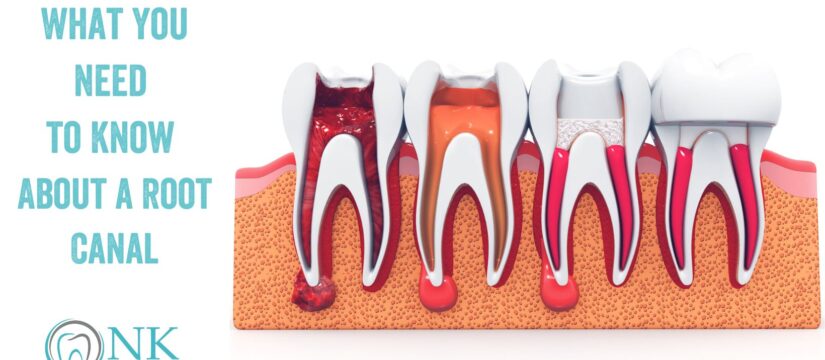
Root canal treatment is probably the dental procedure that people dread the most. In fact, it’s the standard reference for an unpleasant experience, as in, “I’d rather have a root canal than (fill in the blank).” If you’ve never had a root canal, the procedure’s bad reputation could make you so anxious that you don’t seek treatment if you have symptoms — which will lead to an even worse situation. If you had a root canal years ago, your memories may be of long, uncomfortable treatments involving hours in the dental chair over two or more visits.
Fortunately, medical advancements in root canal treatment have made the procedure much faster, and painless when performed by an experienced, skilled dentist or endodontist. An endodontist is a dentist who specializes in diagnosing and treating problems inside the tooth. Endodontists receive two or more years of advanced training after completing dental school in order to further develop their knowledge, skills and use of advanced root canal treatment technology.
In the interest of ending the root canal’s scary reputation for good, the American Association of Endodontists (AAE) reported on a 2019 study by the University of Adelaide on modern root canal treatment, authored by Dr. Tallen Chew and published in the Journal Endodontics (JOE). The JOE study concluded that root canal treatments are currently perceived as no worse than other dental procedures, with more than 25 million root canals treated every year by dentists and endodontists.
What is a Root Canal?
Although the term “root canal” is often used to refer to the procedure, it’s actually part of tooth anatomy. Also known as the pulp canal, it’s located inside the tooth root and contains the pulp, or pulp tissue. This tissue is made up of blood vessels, nerve endings and connective tissue. A tooth develops a root canal infection — also known as irreversible pulpitis — when decay spreads to the pulp, or when a bacterial infection develops inside the tooth or at its root tip. It must then be removed from the canal in order to stop dental pain and prevent infection from spreading throughout the body — which can lead to sepsis, a life-threatening medical emergency.
The AAE explains root canal treatments as follows:
“Root canal treatment is designed to eliminate bacteria from the infected root canal, prevent reinfection of the tooth and save the natural tooth. When one undergoes a root canal, the inflamed or infected pulp is removed and the inside of the tooth is carefully cleaned and disinfected, then filled and sealed.”
While the tooth structure remains intact, it is no longer “alive” so to speak. This eventually makes it brittle and fragile, which is why the final step is to place a crown over the tooth. The restoration gives the tooth strength and protection so it functions just as before. Crowning also provides an aesthetic benefit, as the tooth may become discolored.
How Can I Tell if I Need a Root Canal?
Because of its reputation, many people delay seeking treatment, hoping that symptoms will go away on their own (which never happens). Only a dentist can confirm if your tooth’s pulp is infected or inflamed and will require root canal treatment, but there are some key symptoms to watch for:
Persistent pain — Feeling constant or persistent pain in a tooth, jaw, face or surrounding teeth is a major symptom. This could also indicate gum disease, a cavity, a damaged filling, an infection in an impacted tooth and other dental conditions. Always consult your dentist immediately when you experience any form of tooth pain.
Pain upon touching the tooth or eating — If your tooth is sensitive to both cold and hot beverages/foods, this could be a sign that the nerve endings and blood vessels in your tooth pulp are affected. You might feel either a sharp pain or a dull ache that persists for a while after drinking or eating. According to Kenneth Rothschild, DDS, in his interview for Healthline, “The ligament around the root tip of an infected tooth may become hypersensitive from the pulp dying. The waste products from the dying pulp may irritate the ligament, causing pain from biting pressure.”
Swollen gums — In addition to being a sign of periodontal (gum) disease, swollen gums could be caused by problems with a tooth’s root, especially if the swelling is concentrated near a single tooth that is causing pain. Gums may be tender to the touch, the swelling may be persistent, or it may come and go. The swelling could be caused by infected or dead tooth pulp, and it could also include an abscess containing fluid known as pus. As Dr. Rothschild explains, swelling occurs when the acidic waste products released by dead pulp tissues react with the root or surrounding areas of your tooth. Instead of swelling, you may also have an abscess, gum boil, or parulis.
Tooth mobility — If your tooth feels loose, the pulp could be infected, and the nerve endings could be dead. Acidic waste products caused by nerve death can soften the bone around the tooth’s root, causing mobility. However, a loose tooth is only a potential sign of needing a root canal if just one tooth is loose. More than one tooth likely indicates other serious dental conditions.
Tooth discoloration — An infection in your tooth pulp can lead to tooth discoloration. Dark grayish-black coloration seen from the external front of a tooth can be a major sign of internal root tissue damage and infection.
How is a Root Canal Performed?
As our blog post — “What to Expect with a Root Canal” — covers, there are seven core steps to this procedure. Your dentist or endodontist will explain what root canal treatment involves, but here is the breakdown:
- Another exam and set of X-rays — While your endodontist or dentist already conducted an exam and took X-rays, doing so once more just before the procedure helps ensure all the correct necessary preparations have been made.
- Oral numbing — Local anesthesia will be used to numb the infected tooth and the area around it. Sedation is not a requirement for root canals, but you may be able to request it from your dentist prior to the procedure to help with anxiety. You can read more about sedation on our blog post, “What to Expect with IV Sedation.”
- Rubber dam placement — To prevent further bacteria from reaching the tooth, a rubber dam (typically a latex sheet), will be placed over your mouth. Medications used inside the tooth will also be prevented by the dam from being swallowed.
- Tooth opening — Your dentist or endodontist will then drill open the top of the tooth.
- Removal, cleaning, and shaping — The infected pulp is removed using very precise tools, followed by the interior of the tooth being cleaned out and shaped.
- Tooth irrigation — The now-empty pulp chambers are irrigated with water. This may also be followed by an antibacterial agent.
- Filling and sealing — Once the interior of the tooth is dry, the tooth will be filled and sealed. The filling is generally a combination of gutta-percha (a natural polymer) and rubber cement, although posts can also be included as needed. You will also receive a temporary filling to top the tooth until you later receive a permanent crown.
Presenting Root Canal Treatment in a New Light
Root canal treatment has become as advanced as every other type of dental procedure, making it painless and convenient. And when you have your root canal procedure performed at NK Family Dental, you’ll experience treatment by our outstanding root canal specialist, Dr. Sabek. Our spa-like office provides an atmosphere that is modern, tranquil and inviting, designed for the ultimate in comfort.
It is our mission to provide the highest quality and most compassionate oral care to our Chicago patients, including both dental and periodontal services. Our practice is trusted for advanced oral surgery procedures and — of course — comfortable root canal treatment.
Our team of experienced, dedicated dental professionals will help address your oral health concerns, and determine the best solution for you based on your individual situation. We strive to identify treatment options that fit your needs. Our dental specialists include our general dentist, Dr. Nilofer Khan, our endodontist, Dr. Sabek, and our periodontist, Dr. Amir Danesh. Dr. Danesh is a board-certified periodontist and Diplomat of the American Board of Periodontology. He has contributed to the publication of two books, as well as published over 20 papers in prestigious dental research journals.
We serve the neighborhoods of Logan Square, Bucktown, Humboldt Park, and Wicker Park with the dedication that’s earned us the reputation as the Best Dentist in Chicago!
We understand that the main concern you may have is cost, which is why we accept all major PPO plans for dental insurance and also offer our in-house dental plan. Please see our financing page for more information.
Schedule your visit through ZocDoc, or contact us directly. We look forward to treating you soon!
